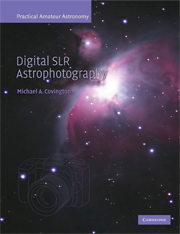2 - Main technical issues
Published online by Cambridge University Press: 21 August 2009
Summary
This chapter is an overview of the main technical issues that affect DSLR astrophotography. Many of these topics will be covered again, at greater length, later in the book.
Image files
File size
Compared to earlier digital astrocameras, the images produced by DSLRs are enormous. Traditional amateur CCD cameras produce images less than 1 megapixel in size; DSLR images are 6–12 megapixels, and still growing.
This has several consequences. First, you can shrink a DSLR image to a quarter of its linear size (1/16 its area) and still put a decent-sized picture on a Web page. That's an easy way to hide hot pixels and other defects without doing any other processing.
Second, you're going to need plenty of file storage space. It's easy to come home from a single evening's work with a gigabyte of image files, more than will fit on a CD-R. Invest in a relatively large memory card for the camera, a fast card reader for your PC, and perhaps a DVD burner for storing backup files.
Third, older astronomical image processing software may have trouble with large DSLR images. Regardless of what software you use, you'll need a computer with ample RAM (at least 1–2 GB recommended) and an up-to-date operating system (but not too new for your older DSLR). Smaller astronomical CCDs work well with older, smaller laptops, but DSLRs do not.
Raw vs. compressed files
Most digital photographs are saved in JPEG compressed format.
- Type
- Chapter
- Information
- Digital SLR Astrophotography , pp. 14 - 25Publisher: Cambridge University PressPrint publication year: 2007



